Antifungal Drugs Market Size
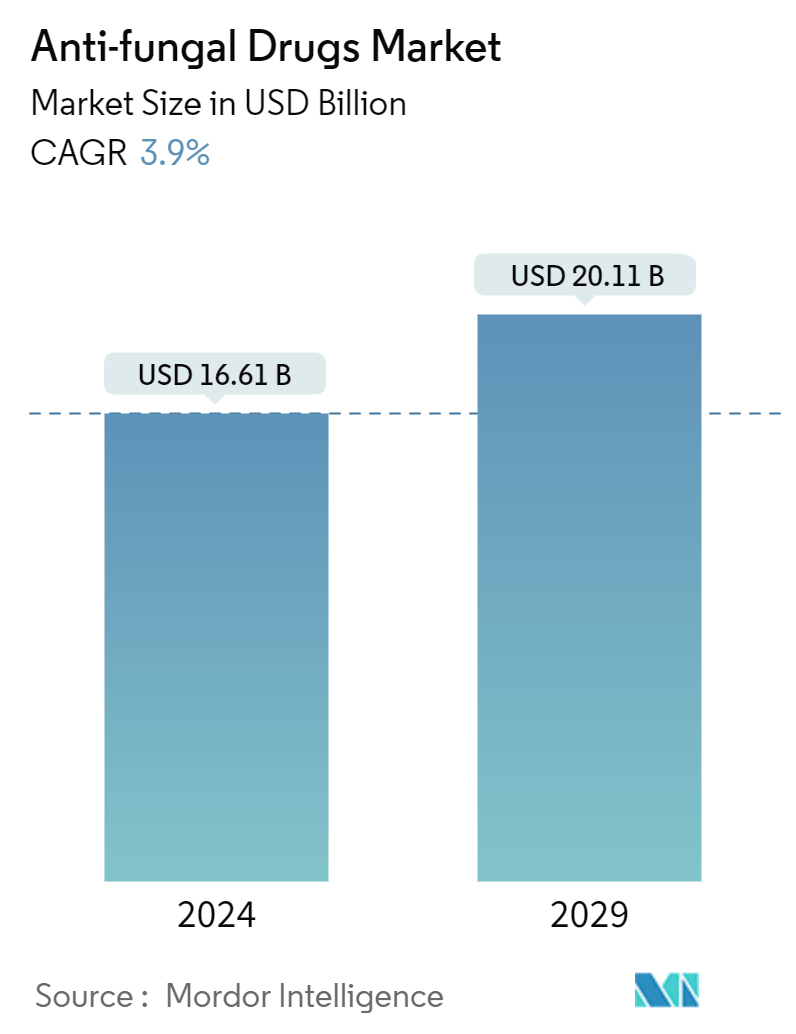
| Study Period | 2019 - 2029 |
| Market Size (2024) | USD 16.61 Billion |
| Market Size (2029) | USD 20.11 Billion |
| CAGR (2024 - 2029) | 3.90 % |
| Fastest Growing Market | Asia Pacific |
| Largest Market | North America |
Major Players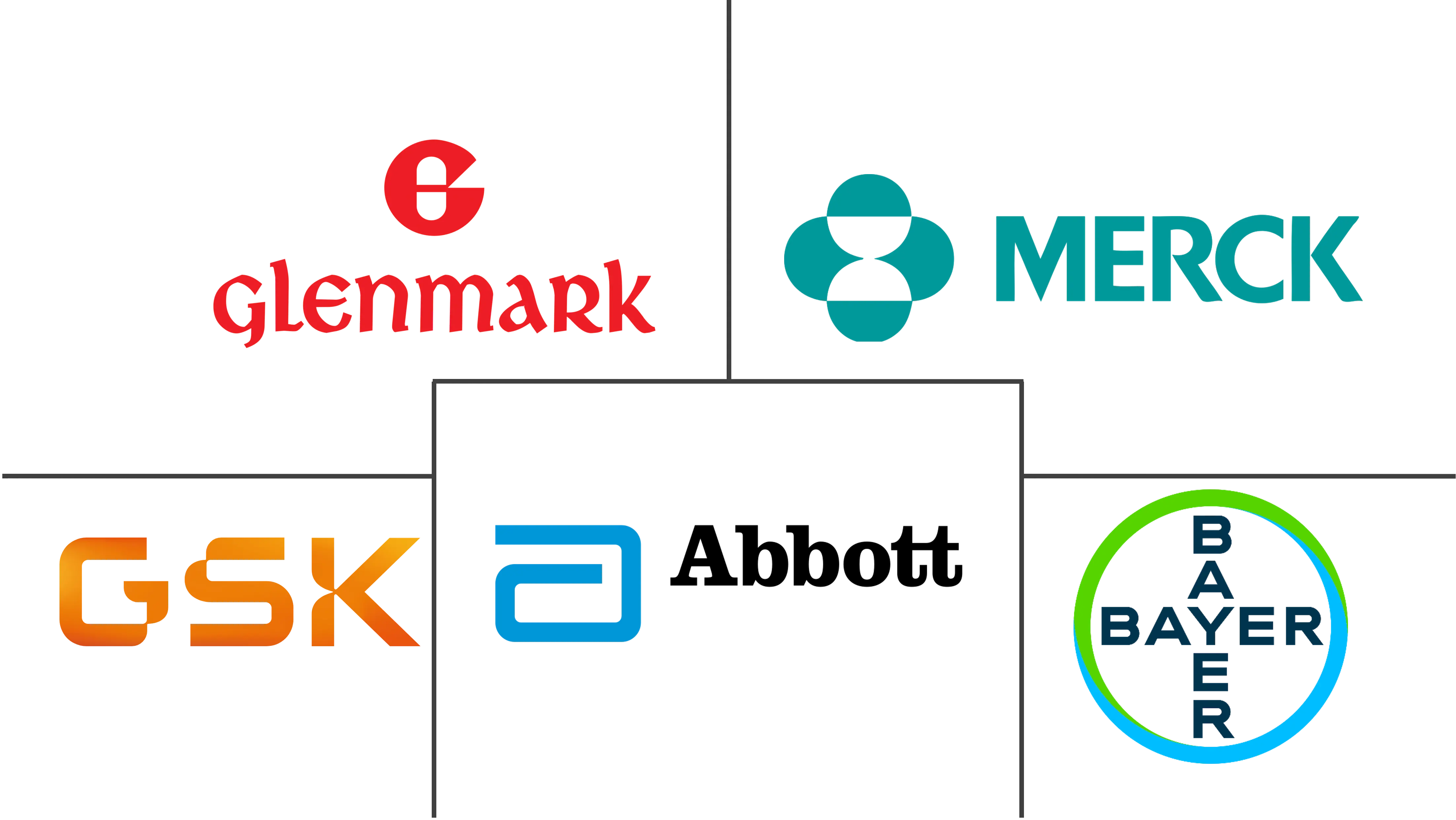
*Disclaimer: Major Players sorted in no particular order |
Antifungal Drugs Market Analysis
The Anti-fungal Drugs Market size is estimated at USD 16.61 billion in 2024, and is expected to reach USD 20.11 billion by 2029, growing at a CAGR of 3.9% during the forecast period (2024-2029).
The major factors contributing to the growth of the anti-fungal drugs market include increased awareness of many fungal infections, rising numbers of over-the-counter (OTC) anti-fungal drugs, and increased use of antimicrobial drugs in developing countries. The growing popularity of OTC drugs such as clotrimazole, econazole, ketoconazole, miconazole, and amorolfine has resulted in many patients using OTC drugs.
An increase in onychomycosis cases, a fungal infection of the fingers and toes, is also expected to contribute to the market’s growth. For instance, according to the data updated by the CDC in September 2022, onychomycosis affected up to 14% of the general population in the world, and fungal toenail infections became more common than fungal fingernail infections.
Additionally, excessive glucose can lead to high cellular damage, resulting in several infectious and non-infectious skin disorders. Therefore, diabetes patients are more susceptible to various fungal infections, and onychomycosis is one of the major infections among the target population. For instance, according to an article published in the Journal of Fungi in August 2022, when a group of people was studied for skin and nail disorders in diabetic patients, onychomycoses were found common in critically ill diabetic patients.
Furthermore, the same study stated that dermatophytes were found to be the commonest cultural isolates (50%), followed by yeasts and molds in 30.8% and 19.2%, respectively, of the diabetes patients. Hence, the high burden of diseases among the target population is expected to increase the demand for antifungals and contribute to the overall growth of the market studied over the forecast period.
Moreover, the increasing focus of companies on adopting key strategic activities such as product launches, mergers and acquisitions, collaborations, and partnerships is further expected to boost the availability of anti-fungal drugs in the market over the forecast period. For instance, in June 2022, Apex Labs introduced the advanced Supra Bioavailable Itraconazole 65 and 130 mg capsules, a potent therapeutic option for effectively controlling fungal infections. Supra Bioavailable Itraconazole capsules deliver a higher percentage (90%) of active medicine to the biological system at a lesser dose. This advanced preparation also ensures lesser inter-individual variability, which may translate into enhanced efficacy in the management of fungal infections, according to a statement from the company.
Thus, the growing incidence of fungal infection and strategic activities adopted by market players is expected to contribute to market growth over the forecast period. However, increasing resistance to anti-fungal drugs and the side effects of these drugs are anticipated to hinder their adoption and demand, thereby restraining the market's growth.
Antifungal Drugs Market Trends
Azoles Segment Expected to Witness Significant Growth During the Forecast Period
The azole group of compounds are anti-fungal agents that have greatly expanded therapeutic options for treating systemic fungal infections. Research in the field of fungal drugs is growing rapidly, which has accelerated the development of new anti-fungal drugs using the azole group. Synthetic azoles and semi-synthetic compounds are widely used for fungal infections, and as a result, the segment is expected to register significant growth during the forecast period.
Azole group drugs are used to treat a variety of fungal infections, including thrush, yeast infections, candidiasis, aspergillosis, tinea versicolor, athlete's foot, jock itch, ringworm, systemic mycosis, and seborrheic dermatitis. The azole antifungal group includes two phases: triazoles (fluconazole, itraconazole, voriconazole, posaconazole, and isavuconazole) and imidazoles (ketoconazole).
Various research was conducted to study the efficacy of azoles in treating a variety of fungal infections. For instance, according to the study article published in Plos Pathogens in August 2023, azoles were the most widely used antifungals due to their accessibility, low toxicity, and a broad spectrum of action. They inhibited the ergosterol-synthesis enzyme encoded by ERG11, leading to the accumulation of toxic sterols, loss of membrane integrity, and growth arrest. Thus, the significant efficacy of azole derivatives toward fungal diseases is expected to increase their demand, thereby contributing to the segment’s growth.
Additionally, triazoles have a wide range of applications in the treatment of external fungal infections and systemic infections. The azole group provides a broad spectrum of activity and improved safety standards. These medications have fewer side effects and drug interactions and improved absorption and distribution properties. Thus, the benefits offered by azoles contribute to their superiority over other components, which are further expected to fuel the segment’s growth over the forecast period.
Furthermore, the development and innovation of such potential drugs promote the competitiveness of the pharmaceutical market. For instance, in September 2023, BDR Pharmaceuticals launched Zisavel capsules to combat invasive aspergillosis and mucormycosis, two fungal infections. Such advancements are expected to drive the growth of the segment during the forecast period.
Thus, with the rising number of research studies related to azoles and new drug launches, the market studied is anticipated to boost the segment’s growth over the forecast period.
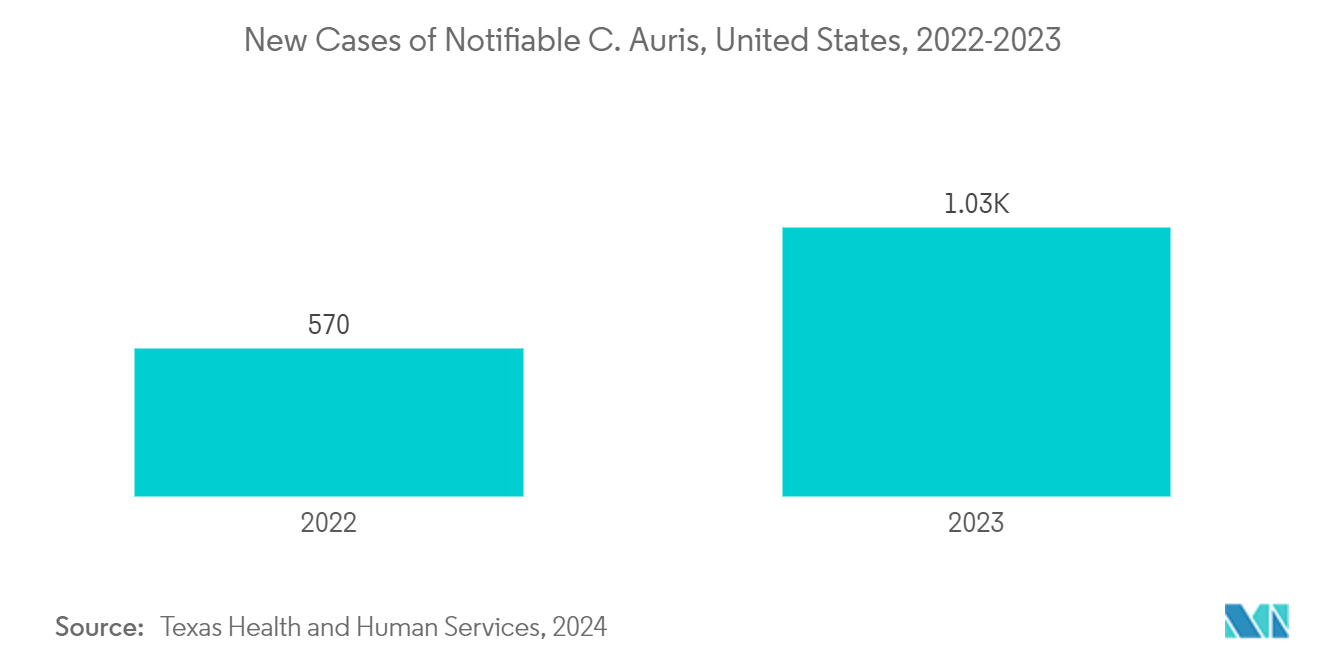
North America is Expected to Hold a Significant Market Share Over the Forecast Period
North America is expected to witness significant growth in the market studied. This growth can be attributed to factors such as the increasing burden of fungal infections among the target population and rising company activities for product development across the countries in the region.
The United States is one of the most economically developed countries in the region, among other countries such as Canada and Mexico. However, fungal infections in the country have presented challenges to health authorities. For instance, according to data updated by the Centers for Disease Control and Prevention (CDC) in June 2022, Candida was a common cause of blood-related infections in the United States, and a few drug-resistant strains were also prevalent in the country. Hence, the demand for anti-fungal drugs is growing in the United States.
Additionally, there have been recent outbreaks of fungal infections in Canada, which have fueled the need for anti-fungal drugs for treatment. For instance, in September 2022, as per a press release by Quebec's health ministry, the department dispatched infection control teams to Pierre Boucher Hospital in Longueuil to combat the first-ever outbreak of a potentially deadly fungus, "Candida auris," in Quebec. Candida auris is a type of yeast that can cause severe illness. These instances and the burden of infections have created a potential need for anti-fungal drugs and are expected to contribute to the growth of the market studied in the region.
Moreover, product approvals and launches by market players are further creating competition in the market. For instance, in April 2022, the US Food and Drug Administration (FDA) approved VIVJOA (oteseconazole capsules), an azole antifungal indicated to reduce the incidence of recurrent vulvovaginal candidiasis (RVVC) in females. Such company activities and the burden of fungal infections are anticipated to accelerate market growth in the region over the forecast period.
Therefore, owing to the high burden of fungal infections and rising new product launches by the key players, the market studied is expected to grow over the forecast period.
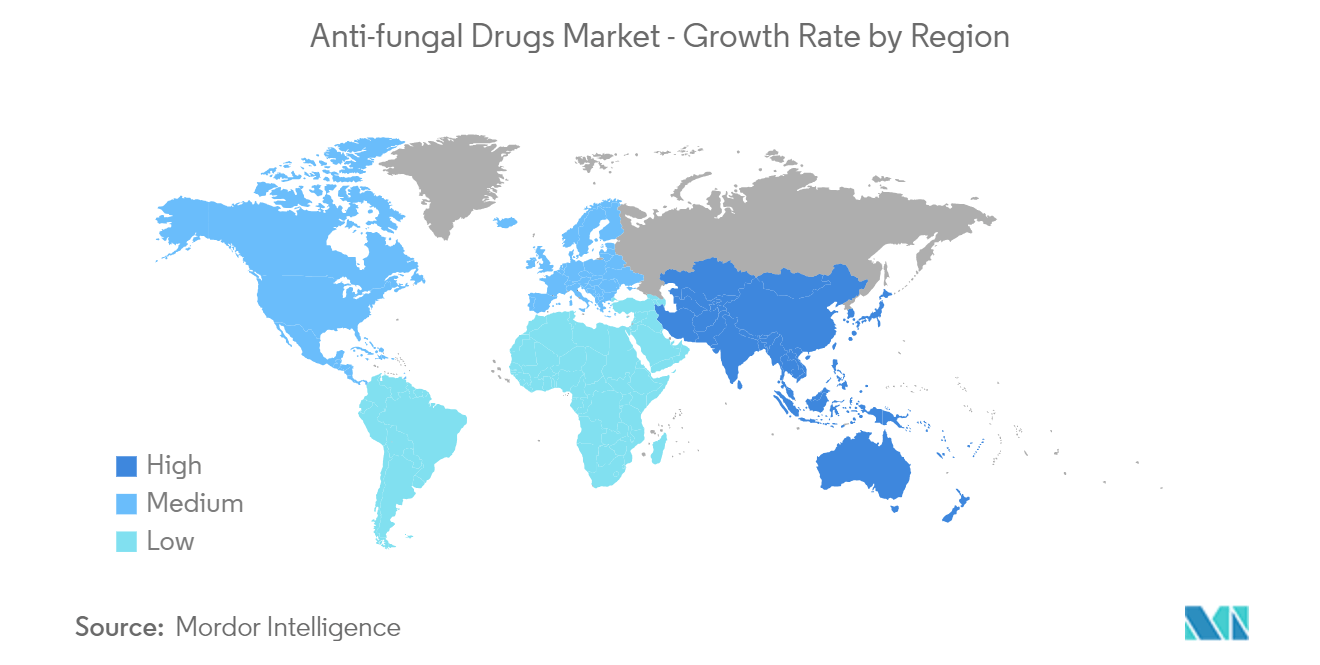
Antifungal Drugs Industry Overview
The analyzed market is fragmented, primarily due to the presence of a limited number of smaller players and several major industry players. The market participants are actively engaged in launching new products and obtaining approvals for them, which is anticipated further to intensify the competitive environment within the studied market. Among the significant market players are Abbott Laboratories, Bayer AG, Astellas Pharma Inc., Glenmark Pharmaceuticals Limited, GSK PLC, Merck & Co. Inc., Novartis AG, and Pfizer Inc.
Antifungal Drugs Market Leaders
-
Abbott Laboratories
-
Bayer AG
-
Merck & Co., Inc.
-
Glenmark Pharmaceuticals Limited
-
GSK plc
*Disclaimer: Major Players sorted in no particular order
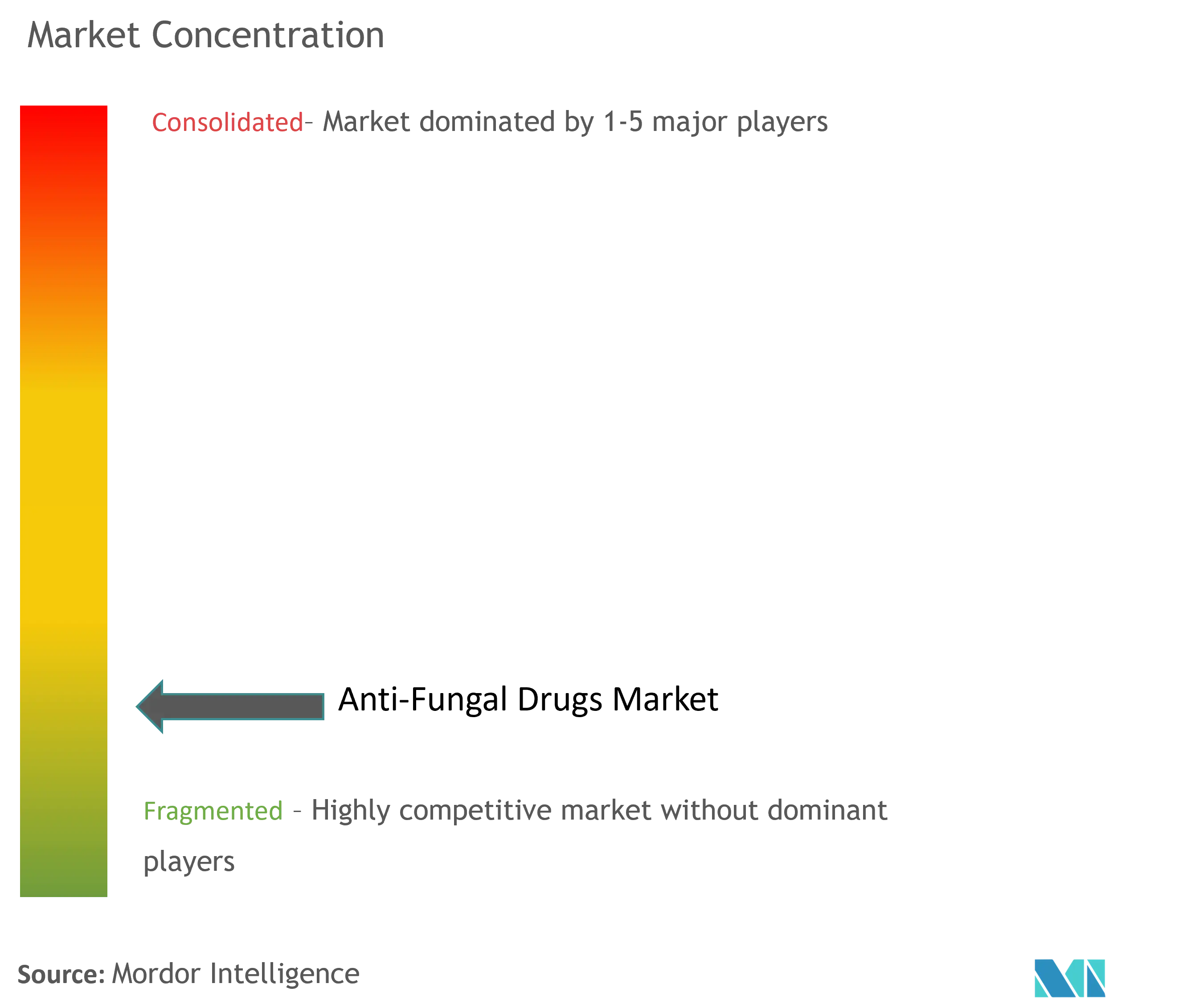
Antifungal Drugs Market News
- June 2024: Elion Therapeutics, a biotech company headquartered in New York, secured USD 81 million in funding through its Series B round. The funding is specifically earmarked for advancing its early-stage polyene anti-fungal therapy, SF001.
- January 2024: Fresenius Kabi introduced Posaconazole Injection, a generic substitute for Noxafil, for use in treating or preventing serious fungal infections in adults and children who have an increased chance of getting these infections due to a weakened immune system.
Antifungal Drugs Market Report - Table of Contents
1. INTRODUCTION
- 1.1 Study Assumption and Market Definition
- 1.2 Scope of the Study
2. RESEARCH METHODOLOGY
3. EXECUTIVE SUMMARY
4. MARKET DYNAMICS
- 4.1 Market Overview
-
4.2 Market Drivers
- 4.2.1 Increasing Awareness about Fungal Infections
- 4.2.2 Increasing Number of Antifungal Drugs as Over-the-counter (OTC)
- 4.2.3 Rising Consumption of Antifungal Drugs in Developing Regions
-
4.3 Market Restraints
- 4.3.1 Increasing Resistance to Antifungal Drugs
- 4.3.2 Side Effects of Antifungal Drugs and Product Recalls
-
4.4 Porter's Five Forces Analysis
- 4.4.1 Threat of New Entrants
- 4.4.2 Bargaining Power of Buyers/Consumers
- 4.4.3 Bargaining Power of Suppliers
- 4.4.4 Threat of Substitute Products
- 4.4.5 Intensity of Competitive Rivalry
5. MARKET SEGMENTATION (Market Size by Value - USD)
-
5.1 By Drug Type
- 5.1.1 Echinocandins
- 5.1.2 Azoles
- 5.1.3 Polyenes
- 5.1.4 Allylamines
- 5.1.5 Other Drug Types
-
5.2 By Indication
- 5.2.1 Aspergillosis
- 5.2.2 Dermatophytosis
- 5.2.3 Candidiasis
- 5.2.4 Other Indications
-
5.3 By Dosage Form
- 5.3.1 Powders
- 5.3.2 Ointments
- 5.3.3 Tablets
- 5.3.4 Other Dosage Forms
-
5.4 By Geography
- 5.4.1 North America
- 5.4.1.1 United States
- 5.4.1.2 Canada
- 5.4.1.3 Mexico
- 5.4.2 Europe
- 5.4.2.1 Germany
- 5.4.2.2 United Kingdom
- 5.4.2.3 France
- 5.4.2.4 Italy
- 5.4.2.5 Spain
- 5.4.2.6 Rest of Europe
- 5.4.3 Asia-Pacific
- 5.4.3.1 China
- 5.4.3.2 Japan
- 5.4.3.3 India
- 5.4.3.4 Australia
- 5.4.3.5 South Korea
- 5.4.3.6 Rest of Asia-Pacific
- 5.4.4 Middle East and Africa
- 5.4.4.1 GCC
- 5.4.4.2 South Africa
- 5.4.4.3 Rest of Middle East and Africa
- 5.4.5 South America
- 5.4.5.1 Brazil
- 5.4.5.2 Argentina
- 5.4.5.3 Rest of South America
6. COMPETITIVE LANDSCAPE
-
6.1 Company Profiles
- 6.1.1 Abbott Laboratories
- 6.1.2 Astellas Pharma Inc.
- 6.1.3 Bayer AG
- 6.1.4 GSK plc
- 6.1.5 Glenmark Pharmaceuticals Limited
- 6.1.6 Arcadia Consumer Healthcare
- 6.1.7 Merck & Co. Inc.
- 6.1.8 Novartis AG
- 6.1.9 Pfizer Inc.
- 6.1.10 SCYNEXIS Inc.
- 6.1.11 Mycovia Pharmaceuticals Inc.
- 6.1.12 Apex Laboratories Pvt. Ltd
- *List Not Exhaustive
7. MARKET OPPORTUNITIES AND FUTURE TRENDS
** Subject To AvailablityAntifungal Drugs Industry Segmentation
As per the scope of this report, anti-fungal drugs are used/prescribed for the treatment of diseases caused by fungi. The anti-fungal drugs market is segmented by drug type, indication, dosage form, and geography. By drug type, the market is segmented as echinocandins, azoles, polyenes, allylamines, and other drug types. By indication, the market is segmented as aspergillosis, dermatophytosis, candidiasis, and other indications. By dosage form, the market is segmented as powder, ointments, tablets, and other dosage forms. By geography, the market is segmented as North America, Europe, Asia-Pacific, Middle East and Africa, and South America). The report offers the value (USD) for the above segments.
| By Drug Type | Echinocandins | |
| Azoles | ||
| Polyenes | ||
| Allylamines | ||
| Other Drug Types | ||
| By Indication | Aspergillosis | |
| Dermatophytosis | ||
| Candidiasis | ||
| Other Indications | ||
| By Dosage Form | Powders | |
| Ointments | ||
| Tablets | ||
| Other Dosage Forms | ||
| By Geography | North America | United States |
| Canada | ||
| Mexico | ||
| By Geography | Europe | Germany |
| United Kingdom | ||
| France | ||
| Italy | ||
| Spain | ||
| Rest of Europe | ||
| By Geography | Asia-Pacific | China |
| Japan | ||
| India | ||
| Australia | ||
| South Korea | ||
| Rest of Asia-Pacific | ||
| By Geography | Middle East and Africa | GCC |
| South Africa | ||
| Rest of Middle East and Africa | ||
| By Geography | South America | Brazil |
| Argentina | ||
| Rest of South America |
Antifungal Drugs Market Research FAQs
How big is the Antifungal Drugs Market?
The Antifungal Drugs Market size is expected to reach USD 16.61 billion in 2024 and grow at a CAGR of 3.9% to reach USD 20.11 billion by 2029.
What is the current Antifungal Drugs Market size?
In 2024, the Antifungal Drugs Market size is expected to reach USD 16.61 billion.
Who are the key players in Antifungal Drugs Market?
Abbott Laboratories, Bayer AG, Merck & Co., Inc., Glenmark Pharmaceuticals Limited and GSK plc are the major companies operating in the Antifungal Drugs Market.
Which is the fastest growing region in Antifungal Drugs Market?
Asia Pacific is estimated to grow at the highest CAGR over the forecast period (2024-2029).
Which region has the biggest share in Antifungal Drugs Market?
In 2024, the North America accounts for the largest market share in Antifungal Drugs Market.
What years does this Antifungal Drugs Market cover, and what was the market size in 2023?
In 2023, the Antifungal Drugs Market size was estimated at USD 15.96 billion. The report covers the Antifungal Drugs Market historical market size for years: 2019, 2020, 2021, 2022 and 2023. The report also forecasts the Antifungal Drugs Market size for years: 2024, 2025, 2026, 2027, 2028 and 2029.
Antifungal Drugs Industry Report
Statistics for the 2024 Anti-Fungal Drugs market share, size and revenue growth rate, created by Mordor Intelligence™ Industry Reports. Anti-Fungal Drugs analysis includes a market forecast outlook to 2029 and historical overview. Get a sample of this industry analysis as a free report PDF download.



